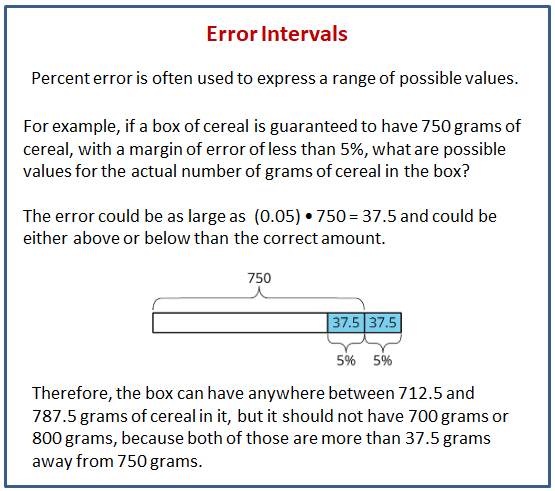Illustrative Mathematics Grade 7, Unit 4, Lesson 15: Error Intervals
Learning Targets:
- I can find a range of possible values for a quantity if I know the maximum percent error and the correct value.
Related Pages
Illustrative Math
Grade 7
Lesson 15: Error Intervals
Let’s solve more problems about percent error.
Illustrative Math Unit 7.4, Lesson 15 (printable worksheets)
Lesson 15 Summary
The following diagram shows how to find the error interval which is a range of possible values for a quantity if I know the maximum percent error and the correct value.

Lesson 15.1 A Lot of Iron Ore
An industrial scale is guaranteed by the manufacturer to have a percent error of no more than 1%. What is a possible reading on the scale if you put 500 kilograms of iron ore on it?
Lesson 15.2 Saw Mill
- A saw mill cuts boards that are 16 ft long. After they are cut, the boards are inspected and rejected if the length has a percent error of 1.5% or more.
a. List some board lengths that should be accepted.
b. List some board lengths that should be rejected. - The saw mill also cuts boards that are 10, 12, and 14 feet long. An inspector rejects a board that was 2.3 inches too long. What was the intended length of the board?
Lesson 15.3 Info Gap: Quality Control
Your teacher will give you either a problem card or a data card. Do not show or read your card to your partner.
If your teacher gives you the problem card:
- Silently read your card and think about what information you need to answer the question.
- Ask your partner for the specific information that you need.
- Explain how you are using the information to solve the problem.
- Solve the problem and explain your reasoning to your partner.
If your teacher gives you the data card: - Silently read the information on your card.
- Ask your partner “What specific information do you need?” and wait for them to ask for information. Only give them information that is on your card. (Do not figure out anything for them!)
- Before telling them the information, ask “Why do you need that information?”
- After your partner solves the problem, ask them to explain their reasoning and listen to their explanation.
Pause here so your teacher can review your work. Ask your teacher for a new set of cards and repeat the activity, trading roles with your partner.
Lesson 15 Practice Problems
- Jada measured the height of a plant in a science experiment and finds that, to the nearest /14 of an inch, it is 4 3/4 inches.
a. What is the largest the actual height the plant could be?
b. What is the smallest the actual height the plant could be?
c. How large could the percent error in Jada’s measurement be? - Water is running into a bathtub at a constant rate. After 2 minutes, the tub is filled with 2.5 gallons of water. Write two equations for this proportional relationship. Use w for the amount of water (gallons) and t for time (minutes). In each case, what does the constant of proportionality tell you about the situation?
- Noah picked 3 kg of cherries. Jada picked half as many cherries as Noah. How many total kg of cherries did Jada and Noah pick?
- The reading on a car’s speedometer has 1.6% maximum error. The speed limit on a road is 65 miles per hour.
a. The speedometer reads 64 miles per hour. Is it possible that the car is going over the speed limit?
b. The speedometer reads 66 miles per hour. Is the car definitely going over the speed limit? - Here is a shape with some measurements in cm.
a. Complete the table showing the area of different scaled copies of the triangle.
b. Is the relationship between the scale factor and the area of the scaled copy proportional?
The Open Up Resources math curriculum is free to download from the Open Up Resources website and is also available from Illustrative Mathematics.
Try out our new and fun Fraction Concoction Game.
Add and subtract fractions to make exciting fraction concoctions following a recipe. There are four levels of difficulty: Easy, medium, hard and insane. Practice the basics of fraction addition and subtraction or challenge yourself with the insane level.

We welcome your feedback, comments and questions about this site or page. Please submit your feedback or enquiries via our Feedback page.